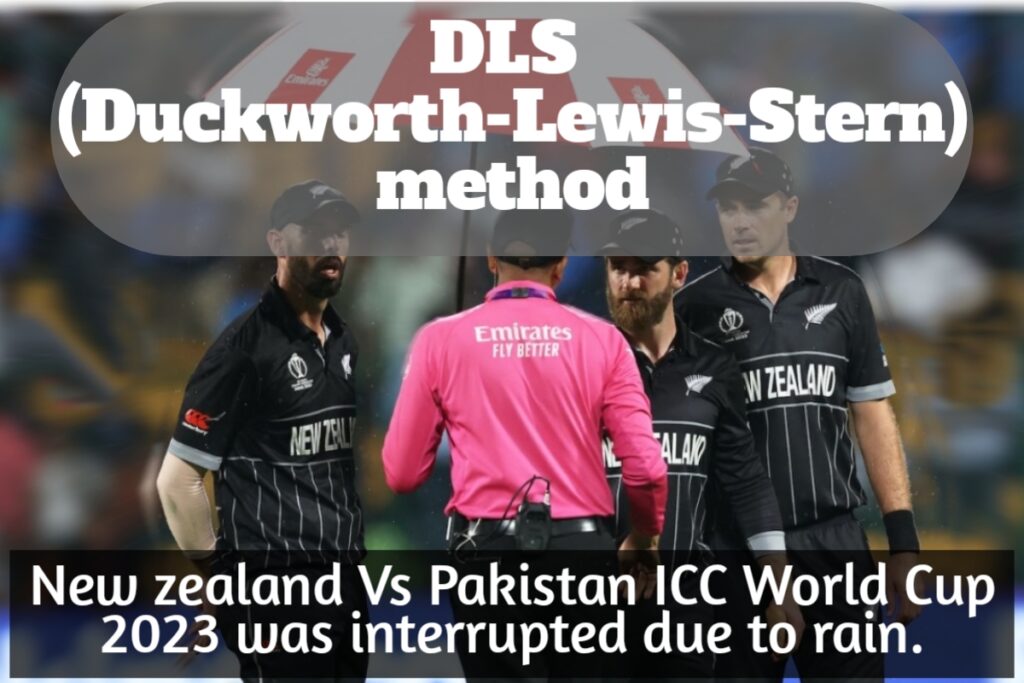Duckworth Lewis Stern method, Why DLS method, Pre-history of calculating Target score in cricket, History of DLS method, calculating target score by DLS method, rules and regulations of DLS method, criticism of the DLS method

The 35th match of the ODI Cricket World Cup 2023, New Zealand vs Pakistan, was played on 4 November 2023 at M Chinnaswamy Stadium, Bengaluru.
This was going to be an exciting contest. New Zealand scored 401 runs losing 6 wickets. Now Pakistan had to complete the target of 402 runs. Pakistan had scored 200 runs in 25.3 overs by losing 1 wicket, but then the match was interrupted due to rain. Due to rain not stopping the game over time, Pakistan was declared victorious by 21 runs using DLS method. The system used when a match is stopped due to rain is called DLS method or Duckworth-Lewis – Stern method.
In the same World Cup 2023, Netherlands was declared victorious against South Africa through DLS method because that match was also interrupted by rain.
The Duckworth Lewis Stern (D/L/S) method is a formula used to calculate a revised target score in cricket matches that have been interrupted by rain or other unforeseen circumstances. The method is regularly updated using data from recent matches.
The Duckworth Lewis Stern (DLS) method
The well-known Duckworth-Lewis (D/L) method, used to determine targets in cricket matches impacted by adverse weather conditions, will make its appearance in the ICC Cricket World Cup with a slight modification. Following Stern Software’s involvement in refining the calculation algorithm back in November 2014, the updated system will go by the name D/L/S method.
What is the full form of the DLS method?
The full form of the DLS method is the Duckworth-Lewis-Stern method. The Duckworth-Lewis -Stern method, abbreviated as DLS.
What is the use of the Duckworth Lewis Stern (DLS) method?
The Duckworth-Lewis-Stern (DLS) method is used to calculate a revised target score in rain-affected in the cricket matches in the world championship. The method is designed to ensure that both teams have an equal chance of winning, regardless of the amount of play that is possible. DLS method will also apply in cricket World Cup 2023.
Why is the Duckworth Lewis Stern (DLS) method used?
The DLS (Duckworth -Lewis-Stern) method is used in cricket to fairly determine target scores in rain-affected matches. It factors in the overs and wickets remaining to calculate adjusted targets, ensuring a more equitable outcome when rain disrupts the game.
When is the Duckworth Lewis Stern (DLS) method used?
Every cricket match is scheduled on a fixed day and time. In these conditions a match is started, played and one is the winner. But sometimes in a match abandoned or start with minimum overs played due to an effect of rain and external conditions. If a match starts and resumes after some time in that case DLS method is used to calculate a revised target score for both teams.
Pre-history of calculating Target score before Origin of the Duckworth Lewis Stern (DLS) method
Before the Duckworth -Lewis-Stern (DLS) method, cricket had other ways to handle rain-interrupted matches. Two common methods were the Average Run Rate and Most Productive Overs methods.
The problem with the Average Run Rate method was that it didn’t consider how many wickets the team batting second lost. So, teams could try to score quickly without worrying about losing wickets, making the comparison with the team batting first unfair.
The Most Productive Overs method had similar issues. It didn’t account for wickets lost and could penalise the team batting second for good bowling by ignoring their best overs when setting the new target.
Both methods often changed the game’s balance and didn’t consider the match situation when rain interrupted play.
History and Creation of Duckworth Lewis Stern (DLS) method,
DLS is a mathematical framework meticulously crafted to ascertain the target score – the required number of runs for victory – for the team batting second in a limited-overs cricket encounter that experiences interruptions due to inclement weather or unforeseen circumstances.
What is the theory of the Duckworth Lewis Stern (DLS) formula?
The Duckworth-Lewis-Stern (DLS) method is a complex mathematical formula used in cricket. Its theory revolves around recalculating the target score for the team batting second in limited-overs matches when rain or other disruptions occur. DLS takes into account various factors, such as the number of overs left, wickets lost, and resources available to both teams, to provide a fair revised target. It aims to ensure that the team batting second has a reasonable chance of chasing down the target, taking into consideration the interrupted game’s unique circumstances.
How do we calculate target score by Duckworth Lewis Stern (DLS) method?
The DLS method works on the basis that each team in a limited-overs match has two resources with score runs, the number of overs to be bowled and the number of wickets in hand. The target score is adjusted proportionally to the change in the combination of these two resources.
For example, if a team loses 5 wickets in the first 10 overs of their innings, they will be considered to have used up more of their resources than a team that has lost only 2 wickets in the same number of overs. As a result, the team that has lost 5 wickets will have a lower target score than the team that has lost only 2 wickets.
Beginning of Duckworth Lewis (D/L) method in ICC international ODI match
The D/L method came into existence thanks to the efforts of two British statisticians, Frank Duckworth and Tony Lewis. This happened after a significant incident during the semi-final of the 1992 World Cup between England and South Africa, where the Most Productive Overs method was employed.
Its inception dates back to 1997, and it received official endorsement by the ICC in 1999. Following the retirements of Duckworth and Lewis, the stewardship of this system transitioned to Steven Stern, prompting its renaming to its current nomenclature in November 2014.
Introduction of Duckworth Lewis Stern (DLS) version,
The original version of the D/L method was introduced in 1996. It was a simple formula that used a single published reference table of total resource percentages remaining for all possible combinations of overs and wickets.
In 2004, a second version of the D/L method was introduced. This version was more complex and handled high scores better than the original version.
In 2009, the D/L method was reviewed for the Twenty20 format. This was because the method was not considered to be appropriate for the shortest version of the game.
In 2015, the International Cricket Council (ICC) implemented the Duckworth-Lewis-Stern (DLS) formula. This formula was developed by Professor Steven Stern and includes some changes to the original D/L method. These changes recognize that teams need to start out with a higher scoring rate when chasing high targets rather than keep wickets in hand.
The DLS method is constantly being updated and refined to ensure that it is as fair and accurate as possible.
Understanding of Duckworth Lewis Stern (DLS) method
Here is simplified points to understand of the DLS calculation in a match:
1. Calculate the percentage of overs that each team has been able to play.
2. Calculate the percentage of wickets that each team has lost.
3. Multiply these two percentages together to get the team’s resource percentage.
4. The team with the lower resource percentage will have a lower target score.
How does the Duckworth Lewis Stern (DLS) method work in a cricket match?
The D/L method is all about using ‘resources’ in cricket. Each team has two ‘resources’ that depend on the number of wickets they have left and the overs they can play. The method calculates a percentage based on these resources, with 100% being when a team has 50 overs and 10 wickets. This percentage is stored in a table or computer. When a match is shortened, the target score for the second team is adjusted up or down using these resource percentages. In the common version used, the adjustment is proportional to both teams’ resources.
Updates in Duckworth Lewis Stern (DLS) method
The DLS method is constantly being updated and refined to ensure that it is as fair and accurate as possible.
The original version of the D/L method was introduced in 1996.
In 2004, a second version of the D/L method was introduced.
In 2015, the International Cricket Council (ICC) implemented the Duckworth-Lewis-Stern (DLS) formula.
Rules and regulations of Duckworth Lewis Stern method
Duckworth-Lewis-Stern (DLS) method will be used to calculate a revised target score for the second team.
In a rain-affected 50-over match, each team must face at least 20 overs for the result to be valid. If the first team reaches 20 overs, the DLS method will be used to calculate the target score. DLS rules for ODIs,
Duckworth Lewis Stern (DLS) rules for ODIs,
50-over matches: In a rain-affected 50-over match, each team must face at least 20 overs for the result to be valid. If the first team is bowled out before 20 overs, the second team will be awarded a win. If the first team reaches 20 overs, the DLS method will be used to calculate a revised target score for the second team.
Duckworth Lewis Stern (DLS) rules for T20s,
T20 matches: In a rain-affected T20 match, each team must face at least 5 overs for the result to be valid. If the first team is bowled out before 5 overs, the second team will be awarded a win. If the first team reaches 5 overs, the DLS method will be used to calculate a revised target score for the second team.
Criticism of the Duckworth Lewis Stern method: Why have some criticisms of the DLS methods?
The Duckworth-Lewis (D/L) method is a way to calculate a revised target score in cricket matches that have been interrupted by rain. However, it has been criticised for a few reasons.
What is the reason for the criticisms of the DLS method?
One criticism is that wickets are weighted more heavily than overs. This means that a team that has lost a lot of wickets but still has a lot of overs left could have a lower target score than a team that has lost fewer wickets but has fewer overs left.
The DLS method does not consider field restrictions, which are rules that make it harder for the batting team to score runs. This could give the second innings team an unfair advantage if the second innings has fewer field restrictions than the first innings. If a match is interrupted by rain, the second innings may not have the same amount of field restrictions as the first innings. This could give the second innings team an unfair advantage.
Finally, some people just find the D/L method to be too complex and difficult to understand.
The 2015 update to the D/L method addressed some of these criticisms. For example, the revised target score is now calculated differently for teams chasing large targets. However, the D/L method is still not perfect, and there are still some people who believe that it is not the fairest way to calculate revised target scores in rain-affected matches.
How many overs before the Duckworth Lewis stern method worked?
The DLS method is a complex one, but it is designed to ensure that the target score is as fair as possible for both teams, even if the match has been interrupted.
DLS formula is used only when both the teams have played a match of 20-20 overs each. Or you can say that after one innings, DLS is used only if the second innings plays up to 20 overs.
What are those key points about the Duckworth Lewis Stern method in this article?
Here are some key points from the article:
1. The D/L method is used to calculate a revised target score in cricket matches that have been interrupted by rain or other unforeseen circumstances.
2. The method is updated regularly using data from recent matches.
3. The original version of the D/L method was introduced in 1996.
4. A second version of the D/L method was introduced in 2004.
5. The D/L method was reviewed for the Twenty20 format in 2009.
6. The ICC implemented the DLS formula in 2015.
7. The DLS method is constantly being updated and refined.


